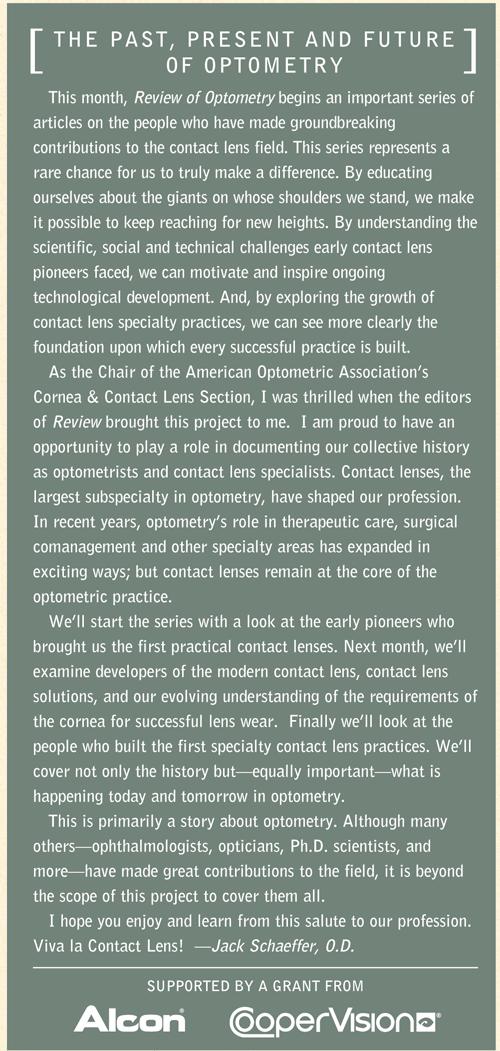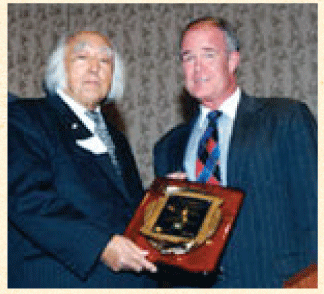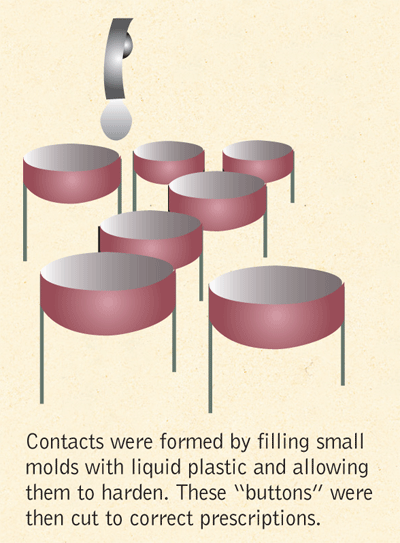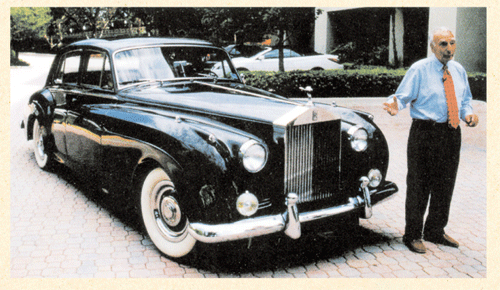 The history of contact lens development is long and rich. As early as the 1500s, the worlds best thinkers already had conceived of the basic principles of contact lenses, even if a true contact lens that could be successfully worn on the eye was still centuries away.
The history of contact lens development is long and rich. As early as the 1500s, the worlds best thinkers already had conceived of the basic principles of contact lenses, even if a true contact lens that could be successfully worn on the eye was still centuries away.
In the late 1880s, glass contact lenses were invented, but that was followed by nearly four decades of very little technological improvement. By the mid-1930s, a few pioneering individuals were about to change the contact lens in dramatic ways. We start this series with the stories of the men who invented and undertook the early development of the modern contact lens. They paved the way for a largely theoretical concept to become reality and for contact lens wear to become a practical method of refractive correction for millions of people.
[ William Feinbloom, O.D., Ph.D. (1904-1985) ]
William Feinbloom graduated from the now-defunct Columbia University School of Optometry in 1923, at the tender age of 19, and began practicing in
 In 1933, he published a paper about his first 500 patients with subnormal vision. In 1939, he received a doctorate in physiologic optics. He went on to design more telescopes, low-vision microscopes, and other visual aids, some of which are still sold by Designs for Vision, an optical products company founded by Dr. Feinbloom in 1961 and currently headed by his son, Richard Feinbloom.
In 1933, he published a paper about his first 500 patients with subnormal vision. In 1939, he received a doctorate in physiologic optics. He went on to design more telescopes, low-vision microscopes, and other visual aids, some of which are still sold by Designs for Vision, an optical products company founded by Dr. Feinbloom in 1961 and currently headed by his son, Richard Feinbloom.
Late in life, when Dr. Feinbloom developed macular degeneration himself, he reportedly saw the silver lining in his condition, noting that only now could he truly understand what his low-vision patients had experienced.
Like many pioneers, Dr. Feinbloom had a strong entrepreneurial spirit. In the 1930s, he developed the Feincone system for fitting scleral lenses and sold the trial lens sets to optometrists all over the country.
When I started practice in 1947, I tried to fit some patients with scleral lenses using this system and even wore them myself for a very short time, remembers Robert Koetting, O.D., founder of The Koetting Associates, in
Dr. Feinbloom was also one of the three original partners in Frontier Contact Lens Company of
But Dr. Feinblooms key contribution to the field of contact lenses was recognizing the many advantages of substituting plastic for glass in the eye. In 1936, he introduced and patented the first contact lens containing plastic. This lens had a central glass optic that covered the cornea with an opaque plastic flange over the sclera.
At the time, glass contact lenses were the standard, but had never been very successful. Glass was transparent, but it had a number of disadvantages, including weight and complete lack of oxygen permeability that rapidly led to discomfort and corneal hypoxia for the wearer. The lenses were also difficult to make.
With plastic, the lens weight could be reduced, the material could be formed and shaped easily, it had good compatibility with ocular tissue, and was more comfortable in the eye than glass.
Initially, Dr. Feinbloom used the only plastic available to himan opaque resin plastic that would not have been effective for the optical portion of the lens. But his ideas were prescient. PMMA, which has superb optical properties, was introduced in the
Many remember William Feinbloom as a tireless advocate. My father was generous with his time and his knowledge, recalls son Richard Feinbloom. And he was passionate about helping people with low vision.
[ Kevin M. Tuohy (1921-1968) ]
In 1948, A California optician who worked for Solex Laboratories, Kevin Tuohy, filed a patent for the first corneal contact lens, which was made entirely of PMMA. His discovery beganas so many dowith a laboratory mistake. A scleral lens was accidentally lathed in two, leaving a smaller corneal button. Tuohy tried the damaged lens on himself to see what would happen. After more experimentation, he filed his patent and published a fitting manual for the new lenses.
Mr. Tuohys contact lens was a large, thick, flat lens with blunt edges that would hardly be considered revolutionary today. But in the late 1940s, it marked a major shift from scleral to corneal contact lenses.
Prior to this, many fine optometrists, ophthalmologists, and scientistsincluding Theodore Obrig, Philip Salvatori, Ernest Mullen, Itsvan Gyorrfy, Solon Braff, and Edward Goodlawhad been designing and producing all-PMMA lenses in scleral designs. PMMA was introduced in the
Because of this, scleral contact lens fitting remained a very limited procedure undertaken by relatively few people around the world. But after the introduction of the Tuohy corneal lens, contact lens sales increased from 50,000 pairs in 1946 to 200,000 pairs in 1949.2
The primary advantage offered by this revolutionary combination of lightweight plastic and a corneal design was the potential for increased tear exchange behind the lens, Mertz says of the Tuohy lens.3 Patient comfort was still a limiting factor, but Mr. Tuohys innovation enjoyed great success by the standards of the day.
The Tuohy lens served as the basis for ongoing design changes to PMMA lenses that dominated the market prior to the introduction of soft contact lenses. The first and most important change was made by George Butterfield, who added peripheral curves to the posterior surface in 1950, introducing the modern concept of fitting the lens on the Ks.1 During the 1950s and 1960s, corneal PMMA lensesmade by Obrig Laboratories, Breger-Mueller-Welt in Chicago, and the Plastic Contact Lens Co (Wesley-Jessen), among othersalso became thinner and smaller.
Unfortunately, PMMA, like glass, is impermeable to oxygen. The resulting corneal oxygen deprivation caused many problems for contact lens wearers that researchers would spend decades more trying to address.
[
 Newton K. Wesley, O.D., is often credited with developing the first commercially successful rigid contact lens, in the mid-1950s. His lens, building on what Tuohy and Butterfield had done, was a 9.2-diameter lens, fit on the flattest K. Its interesting that, all these years later, 9.2 is still the best diameter, said Frank Fontana, O.D., one of the founders of the AOA Contact Lens Section.
Newton K. Wesley, O.D., is often credited with developing the first commercially successful rigid contact lens, in the mid-1950s. His lens, building on what Tuohy and Butterfield had done, was a 9.2-diameter lens, fit on the flattest K. Its interesting that, all these years later, 9.2 is still the best diameter, said Frank Fontana, O.D., one of the founders of the AOA Contact Lens Section.
But his greatest contribution to the field of contact lenses may have been in his teaching skills. Dr. Wesley and a former student of his, George Jessen, O.D., together started the Plastic Contact Lens Company, later to be called Wesley Jessen VisionCare, Inc., a leading manufacturer of specialty contact lenses, including toric, colored and opaque cosmetic lenses. Wesley Jessen was eventually acquired by CIBA Vision in 2001.
Wesley and Jessen taught all of us how to fit contact lenses, Dr. Fontana said. They almost single-handedly developed the market for contact lenses, just by traveling around the country educating people. At the time, contact lens fitting was still a new field, and many thought contact lenses were unsafe; but Dr. Wesley and Dr. Jessen believed wholeheartedly in them. They continued to develop new lenses for decades, achieving FDA approval of their own hydrogel soft contact lenses in 1978.
In 1955, Dr. Wesley founded the National Eye Research Foundation, best known for its orthokeratology and keratoconus work, and remained its chairman for many years. In the 1990s, he pursued software applications for retinal sensitivity analysis. Well into his 80s, Dr. Wesley continued to be an active entrepreneur and innovator.
[ Otto Wichterle, Ph.D. (1913-1998) ]
Otto Wichterle was a brilliant Czech polymer chemist who had already worked on one of the worlds first synthetic fibers. In 1954, he and colleague Drahoslav Lim at the
 When a chance encounter with an ophthalmologist on a train gave Prof. Wichterle the idea that the gels he was working with would also be effective in the eye, he began his successful quest to make a contact lens. He later worked with American collaborator Robert Morrison, O.D., and others to improve the lenses.
When a chance encounter with an ophthalmologist on a train gave Prof. Wichterle the idea that the gels he was working with would also be effective in the eye, he began his successful quest to make a contact lens. He later worked with American collaborator Robert Morrison, O.D., and others to improve the lenses.
The original Wichterle lenses provided relatively poor acuity with thick yellowish material, but they were comfortable, according to Mandell.1 The HEMA material was transparent, free of impurities, and was permeable to oxygen and water-soluble nutrients. Prof. Wichterle patented his lenses in the
 Prof. Wichterle quickly realized that he also needed a faster, more reliable method of fashioning the HEMA material into a contact lens than the closed-mold process hed been using. With various combinations of his childrens construction toys, a hot plate, bicycle parts and a phonograph motor, he built a primitive spin casting devicesomething that was familiar to polymer chemists for other applications but had never been used for contact lenses.
Prof. Wichterle quickly realized that he also needed a faster, more reliable method of fashioning the HEMA material into a contact lens than the closed-mold process hed been using. With various combinations of his childrens construction toys, a hot plate, bicycle parts and a phonograph motor, he built a primitive spin casting devicesomething that was familiar to polymer chemists for other applications but had never been used for contact lenses.
This device was no toy, Morrison said. It was a clever creation in which raw liquid HEMA polymer was introduced via a tube into a mold that was spinning.4 Heat from the hot plate was the catalyst to turn the liquid HEMA into a gel. Technicians at his institute helped him automate the device, which he would later patent (in 1961) as a method for making soft lenses. He and his wife manufactured 5,500 lenses in 1962 with the spin casting machine.1 At the time, he reportedly thought the low cost and high reproducibility of spin casting could make a disposable lens approach economically feasible, although it would be many years before that would become reality.3
Prof. Wichterles contact lens work was often hindered for political reasons and was not fully appreciated until late in his life. When
But while Prof. Wichterle struggled against political forces in his own country, his concept of a lens comfortable enough to be worn for a good portion of waking hours had revolutionized the contact lens field elsewhere. Within just a few years after Bausch & Lomb commercialized his lenses (and the spin casting technique, which the company also acquired), the vast majority of Americans wearing contact lenses were wearing hydrogel contact lenses, and millions of people worldwide still wear them.
[ Robert Morrison, OD (b. 1924) ]
Robert Morrison, a self-described mediocre student, dropped out of college to join the Army during World War II. He decided on optometry because Pennsylvania College of Optometry was accepting veterans without full college degrees. After graduation, the ambitious young doctor built a thriving practice in his hometown of
Wichterles accomplishments might have died behind the iron curtain were it not for the persistence of Robert Morrison, said Joe Shovlin, O.D. Dr. Morrison and Prof. Wichterle traded ideas back and forth over several years, and Dr. Morrison became the first American to fit the lenses in practice. The two were close friends for a while, although the friendship was strained by the legal wrangling that surrounded the transfer of Wichterles HEMA patents.
Dr. Morrison was eager to have the patents in order to continue his own work with soft contact lenses, but he was forced to share them with a group called the National Patent Development Corporation (NPDC). The NPDC bought out Morrisons share soon thereafter and eventually licensed the technology to Bausch & Lomb, which refined it and brought the first soft hydrogel contact lens, the Soflens (polymacon), to market in 1971. The FDA decided the lens was a drug, which created a major hurdle for B&L. Once past that hurdle, however, the company enjoyed a three-year monopoly on soft contact lenses in the
 In addition to serving as the bridge between Otto Wichterle and the West, Dr. Morrison was a skilled contact lens fitter who truly had one of the first optometric practices to specialize in the young field of contact lenses. He became known as the eye doctor of the rich and famous, treating Hollywood stars and international royalty, and once received a Rolls Royce from Queen Juliana of the
In addition to serving as the bridge between Otto Wichterle and the West, Dr. Morrison was a skilled contact lens fitter who truly had one of the first optometric practices to specialize in the young field of contact lenses. He became known as the eye doctor of the rich and famous, treating Hollywood stars and international royalty, and once received a Rolls Royce from Queen Juliana of the
Dr. Bob has shown how much one person can contribute to the world during a lifetime, and how much fun and adventure he can experience while doing it, said Dick Thornburgh, former U.S. Attorney General, former Governor of Pennsylvania, and a longtime patient of Morrisons.
Dr. Morrison enjoyed a long career treating patients, lecturing and teaching. He recently published a book about his life and career.4 I wrote it for my grandchildren, Dr. Morrison said. I wanted to make sure they got the facts straight when they hear some of the tall tales about their grandfather.
All of the individuals described here were path-cutters, charting a difficult way in completely unknown territory. They laid the foundations for both rigid and soft contact lenses and established a role for contact lenses in refractive correction that is now taken for granted. But in some ways, they raised more questions than they answered: What were the oxygen requirements of the cornea? Was there a material that would be comfortable and healthy over the long term? How long could contact lenses be worn? How should they be fit? How did one manage a contact lens practice?
In future installments of this series, well look at the people and the companies that refined lens material and design, built the manufacturing capabilities to revolutionize the industry, educated their colleagues about fitting, marketing, and the oxygen requirements of the cornea, and built the first contact lens specialty practices. 
1. Mandell RB. Historical development. In: Mandell RB. Contact lens practice.
2. Kuwabara DM. History of the Cornea & Contact Lens Section, American
3. Mertz GW. Development of contact lenses. In: Hamano, H and Kaufman H E. Corneal physiology and disposable contact lenses.
4. Knorr R, Kremer K. Man of Vision: The Story of Dr. Robert Morrison. Osprey,

